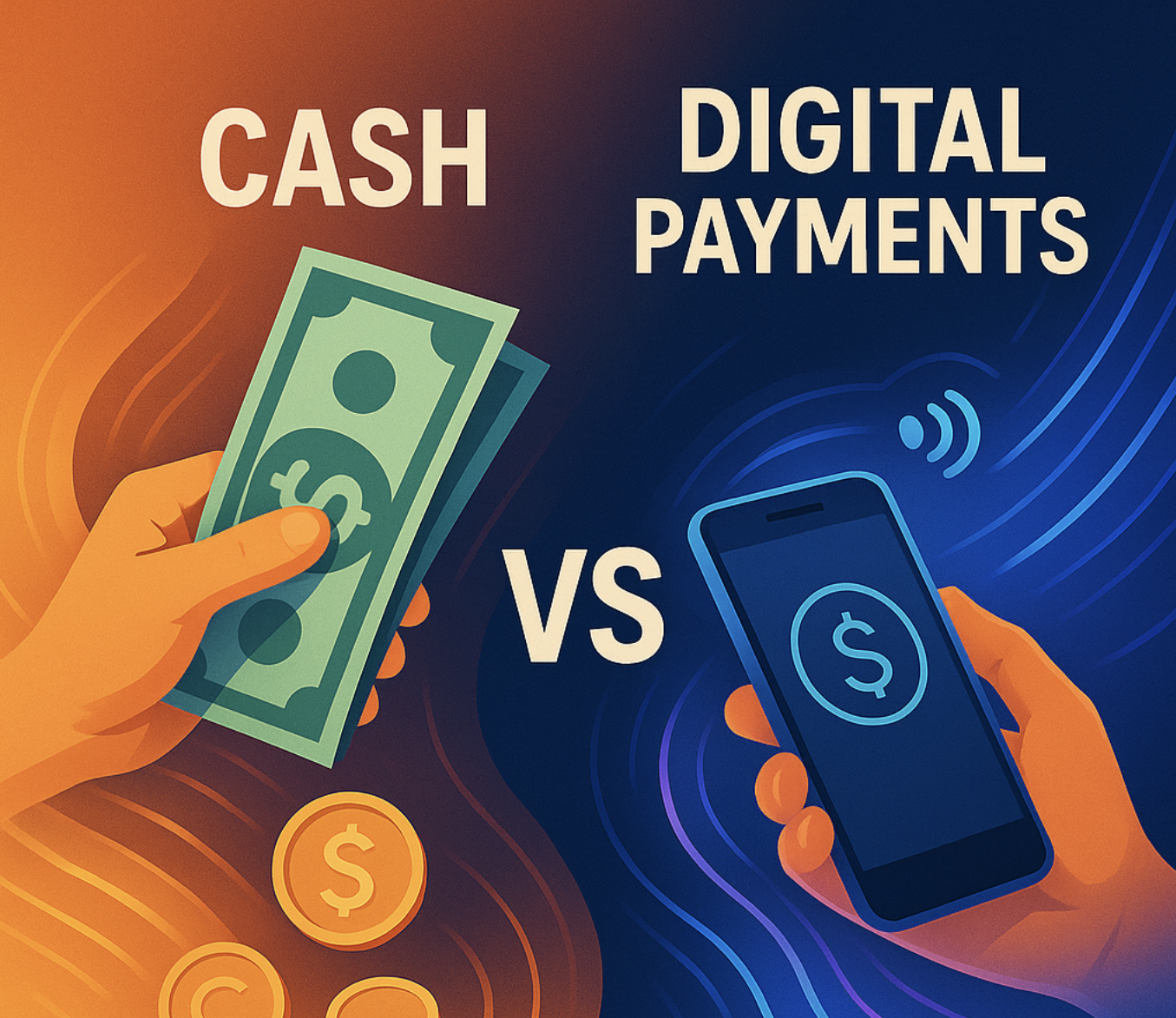With more than 66% of adults worldwide using digital payments, research shows that over 1.4 billion adults remain unbanked. Despite the significant rise in digital payment methods in recent years (and their continual, projected growth), cash is still king, depending on the situation and consumer preferences.
Unsure about when to use cash vs. digital payments? Then, keep reading. Our guide will break down the pros and cons of each method and factors to consider before opting for one over the other. However, Ready Credit’s inclusive digital payment solutions simplify the choice, accommodating all customers, regardless of their payment preference.
Understanding the Differences Between Cash and Digital Payments
While their ends are similar, cash vs digital transactions differ drastically in their means. For instance, a cash payment involves a physical exchange of tangible currency. Whereas a digital payment happens via an electronic method. Here are the most common types of cash and digital payments and why each method can be appealing:
Cash Payments
- Physical currency (i.e., cash and coins)
- Money orders
- Checks
Key attributes
There is no paper trail for cash payments, which is a major plus for spenders who wish to leverage maximum privacy when spending. For unbanked and underbanked consumers, cash provides a simple and tangible means to purchase the goods they need, sans a traditional bank (with fees and interest).
Digital Payments
- Debit cards
- Credit cards
- Prepaid payment cards
- Digital mobile wallets
- Wire transfers
- ACH transfers
- Cryptocurrency
Key attributes
Digital payment methods are quick, convenient, and secure for any consumer on the go. They also boast a traceable e-paper trail, often with real-time spending trackability, giving spenders a stronger grasp over their budgets.
As the saying goes: There’s a time and place for everything, and cash vs. digital payments are no exception. While there is a significant, on-going demand for digital payment options, neither payment method is universally superior in its own right. Ultimately, choosing one over the other depends on consumer preferences and the context surrounding the transaction.
When to Choose Cash Over Digital Payments
1. For Small or Quick In-Person Transactions
Sometimes, depending on your location, a few bills and a pocket full of change can be convenient. From leaving your server an extra tip to paying for local goods at a farmer’s market or your go-to corner store, physical cash comes in handy for its simplicity.
2. In Areas with Poor Connectivity or Infrastructure
Not every merchant or shopping area has the capacity or infrastructure to accommodate digital payments. Whether it’s a mom-and-pop shop without Internet capabilities or a business in an area prone to storm-related downtimes or other outages, cash often reigns as more reliable in these circumstances.
3. When Privacy Is a Priority
Cash allows consumers to keep their spending habits and charitable contributions under lock and key. Without a digital footprint, keeping cash in hand means consumers don’t need to worry about a merchant or third party tracking or storing their spending data, virtually eliminating their vulnerability to data breaches. For cash-carrying customers who still want to make digital purchases without compromising their privacy, Ready Credit’s Cash-to-Card® kiosks offer an anonymous and secure way to load physical cash onto a prepaid card—preserving the benefits of cash while gaining the convenience of digital payments.
4. Personal Preference or Familiarity
We all have our go-to payment preferences. Cash on hand is sometimes more familiar, giving us greater control over our spending. Preference (and tech-savviness) aside, research reveals that U.S. adults age 55+ and households with an annual income of $25,000 or less rely significantly more on cash than digital payment methods.
When to Choose Digital Payments Over Cash
Making Large or High-Value Transactions
When consumers are in the market to make a large or high-value purchase, they don’t visit the merchant with sacks of cash. Not only would that be inconvenient and unmanageable for them and the seller, but it would also be unsafe, making them a target for robbery.
Instead, digital payment methods are significantly more convenient, secure, and traceable. Unlike cash, they offer built-in transaction records for real-time tracking and better budget management. From a business perspective, they also reduce the operational burden of handling physical cash—eliminating the need for cash drawers, armored transport, and the security risks associated with theft or human error.
For Online or Remote Purchases
We can’t make online or app-based purchases with physical cash. This year alone, e-commerce sales are expected to top $4.3 trillion worldwide. Those sales are happening thanks to digital payment methods. Digital payment methods are integral to today’s growing digital economy.
Faster and Contactless Checkout
For customers who want to make a purchase and then get on with their day, counting out physical cash and waiting for change will only slow them down. Instead, digital payment methods, like contactless/tap-to-pay cards, mobile wallets, and QR payments, are convenient, fast, and perfect for public transport, coffee shops, and busy retail venues.
Better Budgeting and Expense Tracking
Digital payment methods are ideal for customers who want greater visibility into their spending. Most methods will come with a digital platform where consumers can view the categories where they spend the most and also set up spending alerts to keep them on track budget-wise.
Some even offer seamless integrations with popular finance apps and banking dashboards for a more transparent and comprehensive view of your expenses.
For Added Security and Theft Protection
Unlike cash, where once it’s lost or stolen, it’s likely gone without a trace, digital payment methods usually come with innate security and theft protection features. From biometric log-in and encryption to two-factor authentication protocols for transaction verification, digital payments are safer and more secure.
When Looking for Rewards or Incentives
Who doesn’t love spending rewards and cashback? Unlike cash, many digital payments come with added perks, bonuses, or app-based promotions that consumers can convert into tangible (and sometimes lucrative) rewards, such as:
- Airline miles
- Hotel stays
- Vacation packages
- Cash-back on purchases
- Limited-time or unrestricted discounts
- Gift cards to other vendors
- Exclusive loyalty-based freebies, discounts, or events
Hybrid Models: Using Cash and Digital Together
More often than not, consumers and businesses won’t need to choose one type of payment method over another exclusively. There’s always room for cash and digital payment methods, depending on the circumstances. For instance, consumers can enjoy greater spending flexibility if they prefer to use cash for small purchases, yet digital methods for larger purchases or recurring bills.
Ready Credit’s cash-to-card kiosks accommodate all customers and businesses, no matter how they want to pay or which payment methods they prefer to accept, respectively.
5 Key Factors to Consider When Choosing a Payment Method
If you’re on the fence about which payment method to use when spending or which to accept in your place of business, consider the following key factors.
1. Security
Keeping cash on your person or in your business carries several security risks. The risk of losing it or being a target for pickpockets is a major safety concern for consumers. As for businesses, collecting and storing physical cash can be a major liability for potential embezzlement or external robbery.
A hybrid approach, such as placing Reverse ATM™ machines on site and more, is a safe and secure way to accommodate customers who prefer cash. No matter what, merchants and consumers must weigh the pros and cons, given their unique circumstances.
2. Convenience
A superior customer experience often centers around convenience. Nobody wants to wait in a long line just to pay. When choosing between cash vs digital payments, consider the following:
- The number of customers per day and their payment preferences
- Crime statistics in your area
- Transaction speed
- Ease of use
- IT/Internet infrastructure and the likelihood of outages and other friction
In cases where transaction speed and ease of use are top considerations, contactless checkout and other digital payment methods may be best. Whereas, if you run a local mom-and-pop shop, you may choose to forego card transaction fees and stick to a cash-based business model.
3. Accessibility
Paying cash doesn’t require any technical savvy, making it appealing to older consumer demographics. It’s also conducive to anonymous spending and convenient for underbanked and unbanked individuals.
Consumers will need a personal electronic device (for mobile wallet payments) or even banking access, which would exclude unbanked consumers unless businesses accommodate them with hybrid digital payment solutions. Likewise, digital payments require businesses to maintain a reliable IT infrastructure and stable operational capabilities, ensuring full accessibility.
4. Transaction context
The type of transaction may guide consumers to choose one payment method over another. Of course, digital payments are the only options for online purchases, but the choice of cash vs digital payments may not be so straightforward for in-person transactions.
You may decide that cash is better for smaller, everyday purchases, such as a coffee or a transport ticket. Whereas, for major or high-value purchases, opting for a digital payment method is safer.
5. Personal values
Sometimes our values will dictate which payment methods to use. If you’re a consumer who prefers to keep their purchases anonymous, sans a paper trail, then cash may be more appealing.
Whereas, if you’re closely monitoring your spending habits and overall budget, tracking tools for spending and card-use alerts may be a better fit. No matter your preference, it’s often best to evaluate each transaction scenario on a case-by-case basis while remaining open to adapting to new and more inclusive payment methods over time.
How Ready Credit Helps Bridge the Gap
The choice between using cash or a digital payment method doesn’t have to be a difficult one. You can have the best of both worlds. Ready Credit’s inclusive digital payment solutions, such as Cash-to-Card® Kiosks, contactless ReadyCARD® prepaid debit cards, and mobile or wearable digital wallets, accommodate cash-paying customers and businesses ready to go cashless in an ever-evolving digital world.
From allowing unbanked customers to conveniently make purchases to accommodating merchants in public venues and events to accept cash and digital payment methods, Ready Credit’s payment solutions make the transition toward a cashless or hybrid payment model easy and inclusive.
Making the Right Choice: Cash or Digital Payments?
There is a time and place for cash and digital payment methods. Each serves a different need depending on the customer’s preferences and the context of any transaction.
In a global economy that is steaming ahead with accommodating digital payments, it’s crucial that businesses never leave their cash-paying customers behind. Inclusivity and flexibility are key to ensuring all customers can purchase what they want, how they want.
Explore Ready Credit’s hybrid digital payment solutions designed to serve every customer, no matter their payment preference.





